LPF Donation via Stripe | LPF Donation - Other Methods
Links below open in new window
ArcticMyst Security by Avery

You are using an out of date browser. It may not display this or other websites correctly.
You should upgrade or use an alternative browser.
You should upgrade or use an alternative browser.
laser crystals bonded with q-switch
- Thread starter op37
- Start date



I did some more work since last post. I made a cavity capable of 4 flash lamps and the rod, plated gold for reflection. The flash lamp used has a diameter of 4mm and length of 44mm. It is with quartz tube. For now each lamp is powered by 600uF capacitors (2 X 1200 uF /360V in series) charged with 540V. All four lamps share the same trigger wire. The lamps are individually wired, so I can connect 1 to 4 in experiment.
I just assembled it today. Triggers was done without focus lens in the picture - direct beam from the rod. The rod used has initial T = 50% of the absorber. I used a roll of black insulating tape in the starting tests. When 2 to 3 flash lamps were lit, there left burn patterns on the taps as the last picture. There were eight dots in the outer circle, four strong and four weak. And 4 weak dots in the inner circle. Mode 14?
I wanted to build a laser range finder with it so I'd like to have mode 00...:thinking:
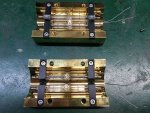
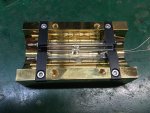
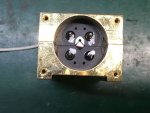
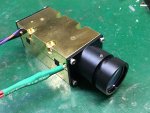
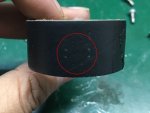
I just assembled it today. Triggers was done without focus lens in the picture - direct beam from the rod. The rod used has initial T = 50% of the absorber. I used a roll of black insulating tape in the starting tests. When 2 to 3 flash lamps were lit, there left burn patterns on the taps as the last picture. There were eight dots in the outer circle, four strong and four weak. And 4 weak dots in the inner circle. Mode 14?
I wanted to build a laser range finder with it so I'd like to have mode 00...:thinking:





- Joined
- Sep 12, 2007
- Messages
- 9,399
- Points
- 113
I hope you have the flash lamps in series, as you cannot operate arcs in parallel. I'm not sure 540V is enough to get all 4 tubes to light either. Your mode problem may be a pump distribution problem (might go away with all 4 firing) or a mirror alignment problem.
Last edited:
- Joined
- Mar 10, 2013
- Messages
- 2,918
- Points
- 113
Cyp is right. You'll want the lamps in series, although with the size you have 1-2 lamps is more than enough if they're Xenon. Cooling and timing are more of your issue here. the flash needs to be strong and probably less than about 50ns to get a good output. My ruby laser (granted it's less efficient than a yag) uses a custom 2x40uF 2800V capacitor, and 2 3" lamps in series to flash pump a 3" rod. Though a ruby has a much longer pulse lifetime, as its florescence lifetime is about 3ms-much longer than that of Nd3+ doped YAG which is on the order of 245us. anything longer than the florescence lifetime is just wasted light in theory and excess heat (but not totally sure how the passive Q-switch would affect this, probably not much). flashing too frequently with only air/convection cooling will crack the lamps or the rod potentially, or even catastrophic shattering of them in an extreme case. good news is YAG dissipates heat much better than ruby does.
As for addressing your mode issue, that's cavity engineering, and a whole separate ball of wax. Almost every flash pumped laser is built for power generally speaking and is multimode due to the gain being so high, and use a planar-planar cavity, which is inevitably going to give you multimode. You could reduce the mode using a concave mirror to make it long radius, but if you recirculate too much power you'll blow coatings off your optical surfaces very fast, sometimes even a single shot will do it if enough power is present. Rangefinders don't have to be TEM00 anyway. To avoid damaging optics, my ruby actually doesn't even have mirrors, and instead has a clever design that lets it recirculate power with other means via a prism and a specially made resonant optic that works similar to an etalon, leaving no surfaces that can be damaged and thus no performance loss.
As for addressing your mode issue, that's cavity engineering, and a whole separate ball of wax. Almost every flash pumped laser is built for power generally speaking and is multimode due to the gain being so high, and use a planar-planar cavity, which is inevitably going to give you multimode. You could reduce the mode using a concave mirror to make it long radius, but if you recirculate too much power you'll blow coatings off your optical surfaces very fast, sometimes even a single shot will do it if enough power is present. Rangefinders don't have to be TEM00 anyway. To avoid damaging optics, my ruby actually doesn't even have mirrors, and instead has a clever design that lets it recirculate power with other means via a prism and a specially made resonant optic that works similar to an etalon, leaving no surfaces that can be damaged and thus no performance loss.
Last edited:
Alaskan
0
- Joined
- Jan 29, 2014
- Messages
- 12,031
- Points
- 113
Got ruby rod rangefinder, finally.... well, at least part of one:

Would be easier and less expensive to just buy one of those solid state diode ones you can find online. What do you want to do with yours?

Would be easier and less expensive to just buy one of those solid state diode ones you can find online. What do you want to do with yours?
- Joined
- Mar 10, 2013
- Messages
- 2,918
- Points
- 113
Oh so you're the one who bought that! Those are cute little things.
Alaskan
0
- Joined
- Jan 29, 2014
- Messages
- 12,031
- Points
- 113
Small, but capable of over 1 megwatt peak power. I paid too much, I thought. Then I saw another one sell for nearly three times the price I paid. What do you think an average price for these are today?
- Joined
- Mar 10, 2013
- Messages
- 2,918
- Points
- 113
Yeah cuz it was new. And usually a few hundred but depends on condition. Technically they're worth as much as a nice car. Mine was 40K in the 70s. So going on a quarter mil in today's money ish?
Mine did about 200mJ in 35ns. But I need to finish realigning it. I may want to borrow yours for OC reflection testing. About 6MW
Mine did about 200mJ in 35ns. But I need to finish realigning it. I may want to borrow yours for OC reflection testing. About 6MW
Last edited:
Alaskan
0
- Joined
- Jan 29, 2014
- Messages
- 12,031
- Points
- 113
According to what I have seen on the net so far, the most these do is about 1.4 MW peak power. Your beacon produces more than 4X that, if that is the one you are referring to.
Can I hope mine will still be properly aligned sitting in a box for decades?
What is so costly to warrant that kind of money, sheer engineering? Engineering is not cheap, especially for leading edge equipment. I think I just answered my own question...
Can I hope mine will still be properly aligned sitting in a box for decades?
What is so costly to warrant that kind of money, sheer engineering? Engineering is not cheap, especially for leading edge equipment. I think I just answered my own question...
Last edited:
- Joined
- Mar 10, 2013
- Messages
- 2,918
- Points
- 113
According to what I have seen on the net so far, the most these do is about 1.4 MW peak power. Your beacon produces more than 4X that, if that is the one you are referring to.
Can I hope mine will still be properly aligned sitting in a box for decades?
What is so costly to warrant that kind of money, sheer engineering? Engineering is not cheap, especially for leading edge equipment. I think I just answered my own question...
kinda. Part of it was that lasers were still fairly new, especially these. They were made by Hughes for the M-60 tank IIRC, before moving to YAGs. The cost is lower for these than for mine. Mine was never a major production item-only a couple were ever made in this configuration, (mine is a portable ruby and self contained) and thus its price is higher due to fabrication costs. The rods are a few thousand dollars alone. lamps are 500-1000 each, plus the prism HR and resonant OCs in these high reliability setups are also quite expensive. not counting the old mechanical Q-switch and stuff. It adds up pretty fast. And that's not getting into power components. Silicon was still new at the time- even simple op amps were 20-30 bucks each in 60's 70's money...basically several hundred dollars. now you can buy them for cents to maybe a couple dollars depending. The motor that drives that Q switch is $$$$ money, held to a very high standard of both reliability and speed consistancy. The list goes on and on...and that's all in today's money, not back then...
Things in general back then were built more rigidly, partly due to desire for quality, partly due to just having no alternative, and when its done on a grant where money isn't really an object....well....welcome to the laser industry, where to this day, things still cost way more than what the actually cost to make, cuz people will pay it.
Last edited:
Alaskan
0
- Joined
- Jan 29, 2014
- Messages
- 12,031
- Points
- 113
Wish I could find some passive Q-switches for 1064nm which can handle more power than a SSY1.
- Joined
- Mar 10, 2013
- Messages
- 2,918
- Points
- 113
Anything more powerful than that probably needs an active one. Passive ones work through absobtion, and even an ssy1 has pretty good power. Anything more would probably damage the optic.
Last edited:
Alaskan
0
- Joined
- Jan 29, 2014
- Messages
- 12,031
- Points
- 113
No wonder I can't find them. Tks.
Did more tests on the four lamps config. I didn't change the lamps into series yet. This will take more time to change the circuit. However all lamps are triggered by the same HV wire. I guess they aren't going to have much difference in flashing time?
Changes were:
1. Lowered the lamp volt to 300V, and increase the cap to 1200uF
2. Replace the rod with initial T=60% one (the T=50% one has gone to heaven when I dropped it on the ground...)
The test config is like that: using a PIN diode to measure the scattered light.
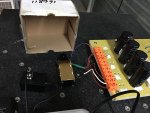
Wave form of long term:
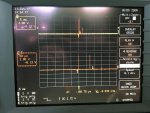
Single pulse:
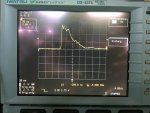
Light pattern:
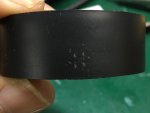
The fluorescent life of ND:YAG is 230uS. We got 2 pulses during one flash, with pulse width about 20ns. The power is unknown yet since I don't have a power meter on hand for now.
Next step i will reduce it to two lamps symmetric and see if can take a picture on the light pattern with a CCD camera...
to Alaskan:
There are these crystals COTS for sale in my area. I am not sure if it is more or less powerful than SSY1. Size is 8X8X4 and 8X8X5mm with initial T = 10%-14%.
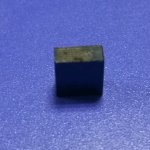

Changes were:
1. Lowered the lamp volt to 300V, and increase the cap to 1200uF
2. Replace the rod with initial T=60% one (the T=50% one has gone to heaven when I dropped it on the ground...)
The test config is like that: using a PIN diode to measure the scattered light.

Wave form of long term:

Single pulse:

Light pattern:

The fluorescent life of ND:YAG is 230uS. We got 2 pulses during one flash, with pulse width about 20ns. The power is unknown yet since I don't have a power meter on hand for now.
Next step i will reduce it to two lamps symmetric and see if can take a picture on the light pattern with a CCD camera...
to Alaskan:
There are these crystals COTS for sale in my area. I am not sure if it is more or less powerful than SSY1. Size is 8X8X4 and 8X8X5mm with initial T = 10%-14%.


Alaskan
0
- Joined
- Jan 29, 2014
- Messages
- 12,031
- Points
- 113
Googling I am not finding anything to know what those COTS are yet, some kind of Q switch? How much, what wavelength?
oh It is CR4+:YAG, about $35 each...V:YAG is cheaper
Also there is EO Q-sw for about $400...
And I am quoting for a microchip laser cavity which is 1.5mm Nd:Yag bonded with 0.5mm Cr:Yag and double side coated with mirrors. Price about $400/pc at quantity of 10.
I modified the volt back to 530V and caps to be 600uF again (because 300V/1200uF/2 lamps it didn't lase). There are two pulses per fire. and The second seems to be not as good.
All pulses
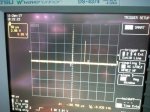
First pulse
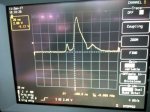
Second pulse

Also there is EO Q-sw for about $400...
And I am quoting for a microchip laser cavity which is 1.5mm Nd:Yag bonded with 0.5mm Cr:Yag and double side coated with mirrors. Price about $400/pc at quantity of 10.
I modified the volt back to 530V and caps to be 600uF again (because 300V/1200uF/2 lamps it didn't lase). There are two pulses per fire. and The second seems to be not as good.
All pulses

First pulse

Second pulse

Last edited:


